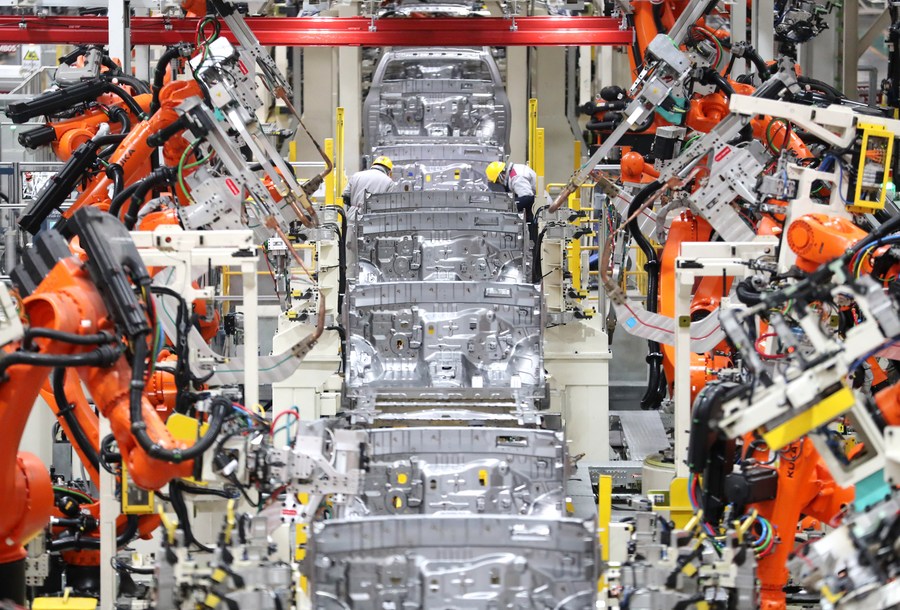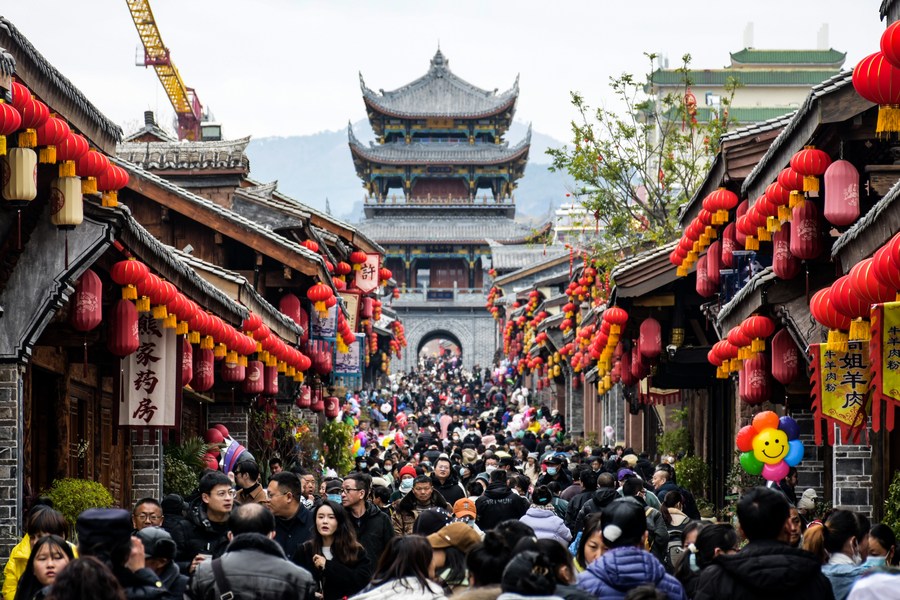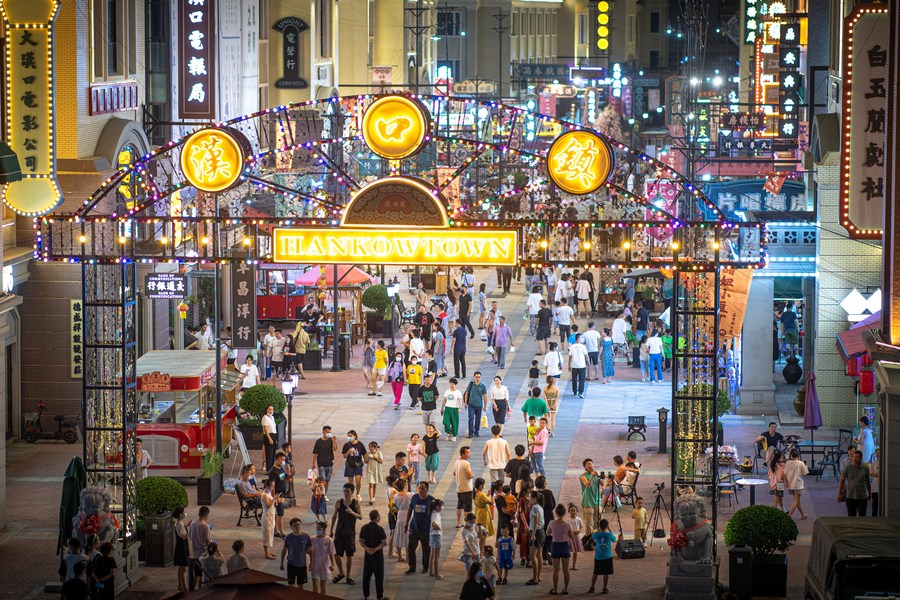

Robots conduct welding work at the workshop of an automobile manufacturing factory in Qingdao, east China's Shandong Province, Jan. 14, 2023. (Photo by Zhang Jingang/Xinhua)
A critical political discussion about modernization in China is currently taking place. Two types of modernization are at stake: the Western one and the one with Chinese characteristics. Western modernization is commonly associated with the cultural upheaval in Europe, so-called modernity, initiated by a complex process of enlightenment, secularization, science and technology, or the bourgeois revolution. Modernity is, therefore, the epitome of emancipation, progress and modernization of society. The terms modernization and modernity have long since seemed to acquire a normative and universal character. They've found their way into our minds all around the planet. Even though progress is described as a universal modernization process, this corresponds to a narrow, euro-centric and partisan view. It understands world history as an Occidental-Western history, as a process of appropriation of the non-European world, to a certain extent as a one-way street of Westernization of the rest of the world, as an export of the "superior" Christian-Occidental and Western-capitalist civilization: Be it in the form of crusades and missionary work, or the form of colonization and optionally also of enslavement. In any case, the result was the subordination of the non-white civilizations. The result in the 19th century divided the world into two parts: the rich world of the privileged minority of the Global North and the poor world of the majority of the colonized and underprivileged of the Global South. The dichotomy was the unquestioned business model in Europe for a long time because it was economically profitable and culturally, religiously and philosophically well-secured. It is well known that this is a devastating model. For this, the colonized peoples, in particular, and then in the 20th century, the countless victims of the world wars instigated by the West, paid their high price in blood. Europe could afford bourgeois democracy and a catalog of rights: liberalism and individual human rights alongside colonialism and racism.

A staff member works at a workshop of Novo Nordisk (China) Pharmaceutical Co., Ltd. in north China's Tianjin, Sept. 22, 2022. (Xinhua/Li Ran)
Even today, a small capitalist oligarchy of the privileged in the G7 countries (the United States, Canada, the United Kingdom, Germany, France, Italy and Japan) seeks to dominate the rest of the world's population, using coercion and violence. In Western societies, it can rely on the complicity of other, so to speak, privileged classes (petty bourgeoisie, privileged wage earners and parts of the intelligentsia). So much for the historical facts from a non-Eurocentric point of view.
Modernization, or rather the achievements of the scientific-technical and capitalist revolutions, has been reserved for a minority of privileged countries. For the rest, they remained an unfulfilled dream. However, there was a turning point in the 20th century. For the first time, the colonized peoples in the so-called Third World countries were encouraged to pursue anti-colonial emancipation and grasp modernization's fruits. For many countries, the Russian October Revolution was the first beacon of an anti-colonial liberation process, which began in the decades after the Second World War. However, it mostly got stuck in formal independence and had to come to terms with the harsh neo-colonial dependencies on Western imperialism. The decolonization process came to a complete standstill after a monopolar world order was established in the 1990s, and the United States, the only remaining world power, felt encouraged again to pursue a more aggressive militarized colonialist foreign policy (Panama, the Gulf Wars, Yugoslavia, Afghanistan, Libya, Syria etc.).
Today we find that the monopolar world order under U.S. hegemony is slowly ending. In the meantime, a lot has happened economically and politically. New players, including China and other large emerging countries, have entered the geopolitical arena. The so-called Washington Consensus, the Western power cartel with its institutional pillars, is being questioned. China's rapid rise to a highly interconnected economic and political world power -- the extent of which was unforeseen by anyone in the West, and (re)entry into world history after an almost two-hundred-year hiatus, form the new beacon at the beginning of the 21st century for the emancipation of the peoples of the Global South, who are mostly still in the stage of neo-colonial exploitation and have not found their way out of poverty and bitterness.
China in the 21st century shows the countries of the Global South that, for the first time, there is again the possibility of extending modernization to most of the world's population and that countries themselves can actively participate in the modernization process. Such a prospect would have been unimaginable in the second half of the 20th century.

People visit Jianchang ancient city during the Spring Festival holiday in Xichang, southwest China's Sichuan Province, on Jan. 27, 2023. (Photo by Li Jieyi/Xinhua)
China's recovery has prompted a reshuffle of the geopolitical cards. The foundation for this lies first in China's successful anti-colonial and socialist revolution, its size and strength in its millennia-old history of civilization and, above all, in its battle-tested party. All of these form the basis for its independence from U.S. hegemony, specifically for its independence from the U.S.-led Western alliance systems (NATO, the transatlantic and its South Pacific expansion) and the economic power instruments (the World Bank, the World Trade Organization, the International Monetary Fund, etc.). China is the author and architect of its modernization and has presented a fantastic track record. It has shown how the absolute poverty of hundreds of millions can be overcome, how productive forces can be developed on an unprecedented scale, and how a fundamental change in the general population's living conditions can be achieved. China's modernization, or modernity made in China, is unprecedented. China has managed to steer modernization in a new direction. So, what are the characteristics of Chinese modernization? -- China's modernization is based primarily on economic, technological and scientific development. China is the technological leader in many areas and will, most likely, increasingly set the pace for innovation. China is in the process of taking a "more efficient path" than that of capitalism and, at the same time, achieving "fairness in society" more effectively. -- China's modernization is more than that. It is a modernization in which the state plays an active role. That is why there is talk of a "hybrid modernity" in the case of China. -- China has long demonstrated that it wants to achieve modernization along a peaceful development path. China is the only country that has become a world power without a military component. -- China's modernization also means the breathtaking construction of a new ecological civilization. The country has long been a global ecological pioneer. -- Last but not least, China's modernization includes its own traditions, philosophy and culture in the social development process. Cultural strength is a crucial element. The combination of economic dynamism and cultural identity makes Chinese modernization strong in terms of civilization. Because China emphasizes respect for its culture, its example is attractive to countries that want to go their own way after being culturally disregarded and economically exploited by the West. China's categorical rejection of "Westernization" must be placed in this context. China confidently says it debunks "the myth" that modernization is "tantamount to Westernization."

This photo shows a night view of a commercial street in Wuhan City, central China's Hubei Province, July 2, 2022. (Xinhua/Xiao Yijiu)
What Chinese modernization promises today is not imperialist exclusion, division and exploitation. Instead, it proposes inclusion with the largest infrastructure project in history, the Belt and Road Initiative. China is working towards a world order based on the mutual benefit of peoples, which accepts different social systems, forming a rational basis for a multipolar order. The people of the Global South, which together with China make up 85 percent of the world's population, can vote for the first time.
Beat Schneider is a Professor Emeritus of Cultural and Design History at the Bern University of the Arts in Switzerland.
The first training camp of the Center of Innovation and Maritime Excellence, supported by Chinese companies, was opened Thursday in Djibouti City, the capital o...